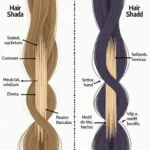Creating realistic skin tones with food coloring can be tricky, but it’s achievable with a bit of knowledge and experimentation. Whether you’re decorating cakes, cookies, or other treats, getting the right shade is key to achieving a lifelike appearance.
Instead of reaching for pre-made skin tone gels, which often lack nuance and vibrancy, consider making your own custom blend using readily available food coloring. This method allows for greater control over the final hue, ensuring it complements your design perfectly.
Understanding the Building Blocks of Skin Tone
Before diving into color mixing, it’s essential to understand the basic components of skin tone:
- Red: This forms the base for most skin tones, representing the natural flush of blood under the skin.
- Yellow: This adds warmth and depth, mimicking the presence of melanin.
- Blue: While used sparingly, blue counteracts the orangey tones that can result from mixing red and yellow. It adds a touch of coolness and realism.
Essential Tips for Mixing Skin Tone Food Coloring
- Start with a White Base: Always begin with white icing or frosting to ensure the colors stay bright and true.
- Add Colors Gradually: Introduce each color drop by drop, mixing thoroughly after each addition. This gradual approach prevents over-saturation and allows for fine-tuning.
- Test on a Small Sample: Before applying to your final creation, test the color on a small piece of parchment paper or icing. This allows you to make adjustments as needed without risking your masterpiece.
- Consider Lighting: Keep in mind that lighting can significantly impact how colors appear. Observe your creation under different lighting conditions to ensure the final result is what you envisioned.
Step-by-Step Guide to Mixing Skin Tone Food Coloring
1. Prepare Your Colors
Gather your red, yellow, and blue food coloring, along with toothpicks or other small tools for mixing.
2. Create a Base Tone
Start with a generous dollop of white icing. Add 2-3 drops of red food coloring, followed by 1-2 drops of yellow. Mix thoroughly until the color is uniform. This creates a warm base resembling a light peach or tan.
3. Adjust for Desired Shade
- For Lighter Skin Tones: Gradually incorporate tiny amounts of white icing until you achieve the desired lightness.
- For Darker Skin Tones: Carefully add more red and yellow, drop by drop, until the desired depth is reached. Use a tiny amount of blue to neutralize any unwanted orange tones.
- For Olive Skin Tones: Increase the amount of yellow in the base, then add small amounts of green (created by mixing blue and yellow) to achieve the desired olive undertone.
mixing-food-coloring-for-skin-tones|Mixing Food Coloring for Skin Tones|A close-up image of a hand using toothpicks to carefully blend red, yellow, and blue food coloring into white frosting, demonstrating the process of creating realistic skin tones for cake decorating.>
4. Fine-Tune and Test
Continuously test the color on a white surface as you make adjustments. Remember that the color will deepen slightly as it dries.
testing-skin-tone-food-coloring|Testing Skin Tone Food Coloring| A white plate with small dabs of different skin tone frostings, each labeled with the color combination used, showcasing the importance of testing and comparing shades before applying to the final creation.>
Expert Insights
“Achieving natural-looking skin tones with food coloring is all about balance and subtlety,” says renowned pastry chef, Amelia Dupont. “Don’t be afraid to experiment with minute amounts of color until you achieve the perfect shade. Remember, less is often more when it comes to food coloring.”
Conclusion
Mastering the art of creating skin tone food coloring opens up a world of possibilities for your culinary creations. By understanding the basic principles of color mixing and following these simple steps, you can achieve stunningly realistic results that elevate your edible artistry. So, embrace the creative process, experiment with confidence, and watch your culinary creations come to life with vibrant, true-to-life hues.
FAQs
1. Can I use gel food coloring instead of liquid?
Yes, gel food coloring can be used. However, start with even smaller amounts as gels tend to be more concentrated than liquids.
2. What should I do if my icing becomes too dark?
If your icing becomes too dark, gradually add small amounts of white icing to lighten it.
3. Can I save leftover skin tone icing?
Yes, you can store leftover icing in an airtight container in the refrigerator for up to a week.
4. My icing looks too pink. How can I fix this?
Adding a tiny drop of blue food coloring can help neutralize the pink tones.
5. What other colors can I use to adjust skin tones?
Besides red, yellow, and blue, you can experiment with violet or brown food coloring to achieve subtle variations in skin tone.
Need Help?
For personalized guidance on color selection and application techniques, contact our team of color experts at Color Box Hà Nội. Reach us at 0373298888, email [email protected], or visit us at 86 Cầu Giấy, Hà Nội. We offer 24/7 customer support to help you create the perfect palette for your culinary masterpiece.

